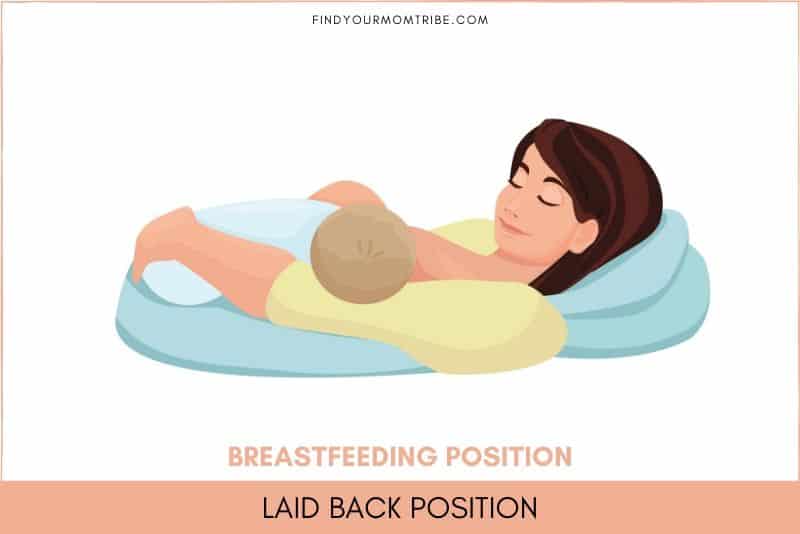One of the first things a mother should try and figure out is how to do laid back breastfeeding.
At first, it is quite challenging to get laid back breastfeeding right as it differs from person to person. Not only does each mom have a different position they prefer, but there’s also another element to factor in, the baby himself.
The baby will have preferences of his own related to finding a comfortable position for latching onto his mother’s breast.
It is vitally important to ensure that the position of the baby’s head is suitable for both the mom and her little one to make sure that he is able to drink enough breast milk.
Trust me when I say that it’ll take a lot of trial and error before you finally get a hold of the situation.
You’ll go through many different feeding positions when you breastfeed that will provide different levels of lactation and you’re likely to suffer from a few bouts of sore nipples and various stages of nipple pain along the way as well.
But, don’t worry! It’s all a natural process of trying to adapt your breastfeeding positions until you get into the swing of things and find the right laid-back position.
One that both provides a good latch for your child where the baby’s body rests comfortably on your form with lots of skin to skin contact and where you can comfortably relax and take a load off.
So, what are some of the more optimal positions to avoid as much pain as possible while providing the most comfort and where you can have your baby latch properly to maintain a regular milk supply in your breasts?
Let’s find out, shall we?
What Is Laid Back Breastfeeding?

This doesn’t need much clarification as laid back breastfeeding, also known as laid back nursing, is pretty self-explanatory.
It is finding a position where you lean back in a way that is relaxing for you and allows your baby’s natural instincts to work, finding a synergy, a symbiosis between the two.
Think of it as establishing a harmony, a rhythm between mother and child that enables both of you to be at peace and allows for the best chances of proper letdown occurring in a timely manner without any drawbacks.
To put it simply, it’s the position that provides the best chances of breastfeeding success.
Because this might be difficult for some newer moms to figure out on their own, don’t hesitate to ask your lactation consultant (IBCLC) or any other qualified healthcare professional for assistance with this matter.
Suzanne Colson, an expert in this field, has actually taken the time to study the positions of both mothers and babies when breastfeeding, focusing on the child’s natural reflexes related to suckling on the breast and the favorite positions of newborns.
One of her most important discoveries was the revelation that all the jostling and flailing that a baby does when he’s trying to find the right position is actually counter-productive to the overall process.
These feeding reflexes have been found to only ever actually be beneficial to the latching process on rare occasion and more often than not should be remedied.
This is most evident in the basic cradle hold where babies frequently struggle against the forced guidance of the mother to lead them to the nipple. This scenario often leads to the point where the baby won’t latch at all and will become fussy.
The rare occasions where these natural reflexes weren’t detrimental were in a more laid back, biological nurturing position.
This is mostly because there’s greater physical contact between mother and child and the baby needs a lot less parental guidance to help find his target.
Little ones prefer doing things on their own as they’re discovering the world and helping facilitate that behavior is going to have the best results as far as latching and co-operation are concerned (as well as most other things).
All you need to do is stick to reclining and let your child do the rest.
This will also allow you to keep your hands free and rest your arms as gravity will do the work instead of you having to exert extra effort to keep your baby in the proper position while you’re standing or something similar.
In the same vein, your child will use a lot less energy keeping his head upright as he can just lay down on top of you and suckle on your breast calmly. There will also be a better chance of him falling asleep if he’s tired.
If you’re having a hard time picturing what your ideal version of laid back breastfeeding looks like, a great example of one of the positions is when you find yourself nursing during bath time.
Imagine sitting down in a bath and reclining against the edge while your baby lies on your stomach and the baby’s mouth fully envelops your nipple, gently suckling, all while you’re in a pool of warm water, potentially with some soft, calming music playing in the background to help keep the baby calm.
Basically, anything that helps you feel even remotely as serene as you would be in that moment would qualify as a good position for laid back breastfeeding.
The Various Laid Back Breastfeeding Positions

As I mentioned previously, the ideal nursing position varies from woman to woman and from child to child which equates to an almost endless amount of different combinations.
Because not every nipple is the same, neither is every breast nor the way every child likes to rest, we have to take a few things into consideration.
And, while it is impossible to find the right position from a few example cases alone, it usually boils down to which one works best for you and then making the small, but necessary adjustments that will make those breastfeeding positions almost perfect.
The ideal biological nurturing position for both breast and bottle feeding
For moms who’ve delivered via vaginal birth, the stomach is the most ideal area on which to place the baby while his little head once again rests on the breast.
This not only provides contact with the baby’s whole front, but it also allows for plenty of eye contact between mother and child all while leaving your hands free to either entertain another hobby should the need arise, or to give your child some much-needed love and attention.
Achieving the ideal position
Regardless of whether the descriptions seem simple or complicated, it all comes down to a few small details you should take note of:
– You should be in a fully supported, semi-reclined position on a comfortable surface.
– Your position should allow for eye contact with your little one to help instill a sense of closeness and security.
– Ideally, your arms should be free to handle the baby and the objects around you without the need to support your baby’s breastfeeding position the whole time.
– You and your child should have as much skin-to-skin contact as possible while still remaining comfortable.
– Your breast should be near the baby’s head because the goal is to breastfeed him but also to provide a place for him to lay his head during breaks.
– (Optional) The less clothing the better as it will allow for more skin-to-skin contact to occur and will help the baby instinctually guide himself toward the breast.
– (Optional) You can still assist your child if he’s having trouble finding the breast, just make sure to keep the level of help as minimal as possible to not have a fussy baby on your hands.
– Some positions may be preferred over others if you have a physical injury (cesarean section scar or the like).
The Caesarean section: the side-lying position

If you had a C-section delivery and your scar is still recovering, you should avoid placing your newborn baby anywhere near the incision area.
This is done simply to avoid any potential kicking, flailing, and overall fussiness from causing any unwanted impact on the area which can sting quite badly.
Instead, what you may want to do is have him in a sort of, side-lying position, one where he’ll be on a comfy surface that won’t cause him to strain his neck too much thus leaving him comfortable enough to latch properly.
The best position for his head in this case is using your breast as a makeshift pillow, one that he’s bound to greatly appreciate when feeding from the breast closer to your heart, allowing for an extra layer of comfort.
This is because your little one has already become used to relating the beat of your heart to something calming, something that provides the comfort and security that helps alleviate any and all fear from their brave little hearts.
The Caesarean section: the upside-down shoulder position

Another option is to place the baby on your shoulder, facing the opposite direction to what he’s normally used to.
It goes without saying that you should be reclined back and horizontal to not risk any potential injury to the baby. Under no circumstances should you attempt this position standing up.
Once again, you should use your breast as a cushion for your child’s precious little head to rest upon and have a comfortable latch with the nipple that’s within lips’ reach.
This way, you’ll leave your C-section scar-free from the risk of any potential injury during a breastfeeding session and you can snuggle up to your little one to your heart’s content while he enjoys a healthy meal.
The Caesarean section: the cross-cradle armpit nest

The final alternative for you C-section mammas is to make a little nest in your armpit by positioning your arm accordingly and placing your child in it while laying down in either a side-lying position or reclining back onto a sofa or something similarly soft.
You then use that nesting area as the spot where your baby can rest safely and leave all of the support down to the surface you’re resting on instead of having to carry the baby yourself.
This way, you’re also providing easy access to breast milk for the baby himself.
Once again, you use your own breast as a soft pillow for your baby to rest his head on should he need a break from breastfeeding or he simply feels tuckered out.
The additional adjustments
Just to be clear, the positions specified as the better ones for women who gave birth through the Cesarean section aren’t exclusive to them.
If you find them more comfortable than the default laid-back position, you are more than welcome to utilize them even if you delivered your baby through vaginal birth.
While all of these might seem ideal, there is always the possibility that something doesn’t feel right with these positions.
Whether you have a latent back problem that makes a position awkward or your child simply seems to dislike being held up on a shoulder due to it being bonier than your stomach area would be, these things can all play a role.
Should it become a problem, simply make some small adjustments to the positioning of your baby or adjust the level of your recline until you find one that won’t inhibit your comfort in any serious way.
Once you manage to find that right balance, you’ve found your ideal position for laid back breastfeeding.
In Conclusion
Laid back breastfeeding isn’t a difficult thing to accomplish by any means.
It is a good approach to breastfeeding as it works well with the baby’s natural instincts and reflexes instead of fighting against them, using them to find a good latch.
It’s all about finding the right position that works best for both you and your child and then making the slight adjustments until it’s just right.
Some of them may require different approaches in case of any physical injuries, C-section recovery scars, or anything else that may be a factor to consider.
If you have any difficulties figuring this problem out on your own, know that your lactation consultant (IBCLC) or any other certified healthcare professional is always at your disposal should you have any questions or are in need of guidance.
They are there to provide a helping hand and no question is irrelevant if it helps make mothering easier, even if just by a little bit.
Happy nursing and I hope the above information will help you find your laid back breastfeeding harmony!
References:
Colson, S. (2012). Biological Nurturing: The Laid-back Breastfeeding Revolution. Midwifery Today, (101), 9.
READ NEXT: 10 Reasons Your Baby Squirms While Breastfeeding
Like this post? Please share or pin it for later. You can also stay in the loop and follow us on Facebook, Instagram or Pinterest.

This post contains affiliate links. Please see our full disclosure for more info.

